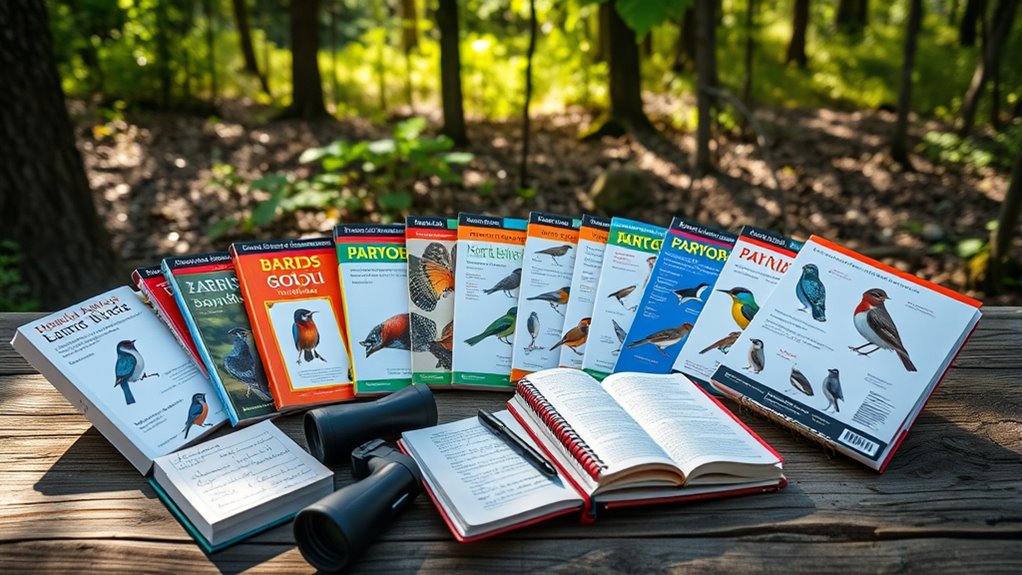If you’re looking to build or improve your birding collection, I recommend exploring top guides like Peterson’s Field Guide to Birds of Eastern & Central North America, the National Geographic Field Guide, and the well-loved Stokes Guides. For more in-depth options, consider the National Audubon Society Guide and Peterson’s second edition. There are also humorous and beginner-friendly choices like The Field Guide to Dumb Birds. Keep reading to discover which guides suit your needs best.
Key Takeaways
- Include a mix of beginner-friendly guides and in-depth reference books for all skill levels.
- Look for guides with clear illustrations, high-quality photos, and detailed range maps.
- Prioritize portable, durable options suitable for outdoor birdwatching adventures.
- Choose guides that feature unique content like bird calls, fun facts, and behavioral notes.
- Ensure a variety of formats, from traditional field guides to humorous or specialized editions.
Peterson Field Guide to Birds of Eastern & Central North America

Are you new to birding and looking for a guide that makes identification straightforward? Peterson’s Field Guide to Birds of Eastern & Central North America is a top choice. It features striking paintings with clear field marks, large illustrations, and detailed descriptions. The book includes range maps, song and call info, and migration data, all on the same page for quick reference. Designed for beginners, it’s durable with glossy pages perfect for field use. While a bit bulky for pocket carry, it’s a trusty resource that helps you learn bird ID confidently. Many birders swear by it as their first stop in the field.
Best For: beginner birders seeking an easy-to-use, visual identification guide with clear illustrations and helpful reference features.
Pros:
- Features large, detailed illustrations with distinctive field marks, ideal for novices
- Includes range maps, song and call descriptions, and migration data on the same page for quick identification
- Durable glossy pages designed for field use, making it suitable for outdoor birding
Cons:
- Slightly bulky for pocket carry, which may limit convenience in the field
- Focused mainly on visual identification, offering less coverage of plumage variations compared to guides like Sibley’s
- May require supplemental resources, such as apps or other guides, for more advanced birders or detailed plumage information
National Geographic Field Guide to the Birds of North America, 7th Edition
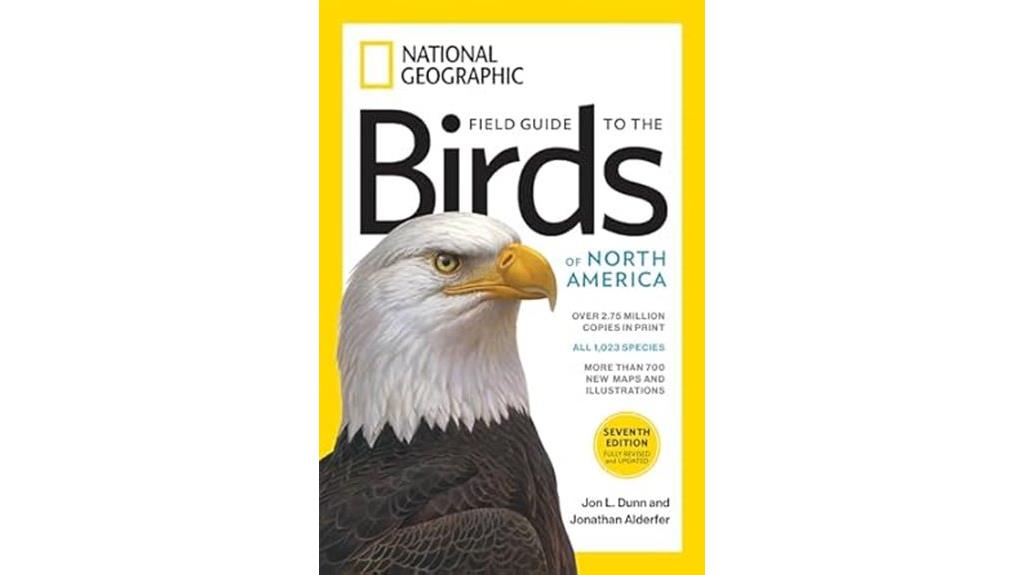
The National Geographic Field Guide to the Birds of North America, 7th Edition, stands out as an ideal choice for both beginner and experienced birders seeking a complete, easy-to-use reference. It covers 967 species with detailed descriptions, high-quality illustrations, and accurate range maps, making identification straightforward. The guide’s thumb tabs, quick find index, and clear layout enhance usability in the field. While some images may vary in vibrancy, overall, it offers exhaustive coverage of plumages and song descriptions. Perfect for travel, quick lookups, or at-home study, this guide combines portability with depth, making it a must-have for any North American bird enthusiast.
Best For: beginner and experienced birders seeking a comprehensive, user-friendly field guide for North American bird identification.
Pros:
- Highly detailed descriptions, illustrations, and range maps that facilitate accurate identification.
- User-friendly features like thumb tabs, quick find index, and clear layout for efficient field use.
- Portable size and sturdy design, making it practical for travel and outdoor birding adventures.
Cons:
- Variability in illustration quality, with some images appearing dull or less vibrant.
- The taxonomic organization follows current scientific standards, which may differ from traditional classifications.
- Range maps reflect current climate shifts and may not align perfectly with older or less updated guides.
National Audubon Society Field Guide to North American Birds, Western Region

If you’re new to birdwatching and want an accessible, visually appealing guide, the National Audubon Society Field Guide to North American Birds, Western Region, is an excellent choice. Its color-oriented layout makes identifying birds straightforward, with vibrant photographs and habitat maps. The sturdy plastic cover withstands outdoor wear, though the book’s weight and thickness mean you’ll need a sizable pocket or backpack. While some may find the separation of images from descriptions inconvenient, the guide offers detailed information on bird size, voice, habitat, and range. Despite layout quirks, it’s a durable, visually rich resource perfect for casual birders exploring Western North America.
Best For: beginners and casual birdwatchers seeking a durable, visually engaging field guide to North American birds in the Western Region.
Pros:
- User-friendly, color-oriented layout simplifies bird identification.
- Durable plastic cover withstands outdoor wear.
- Contains extensive, detailed descriptions of bird species, habitats, and ranges.
Cons:
- Separation of images from descriptions can complicate cross-referencing.
- Layout inconsistencies and digital formatting issues may hinder usability.
- Heavy and thick design requires a large pocket or backpack for portability.
Peterson Field Guide to Birds of North America, 2nd Edition
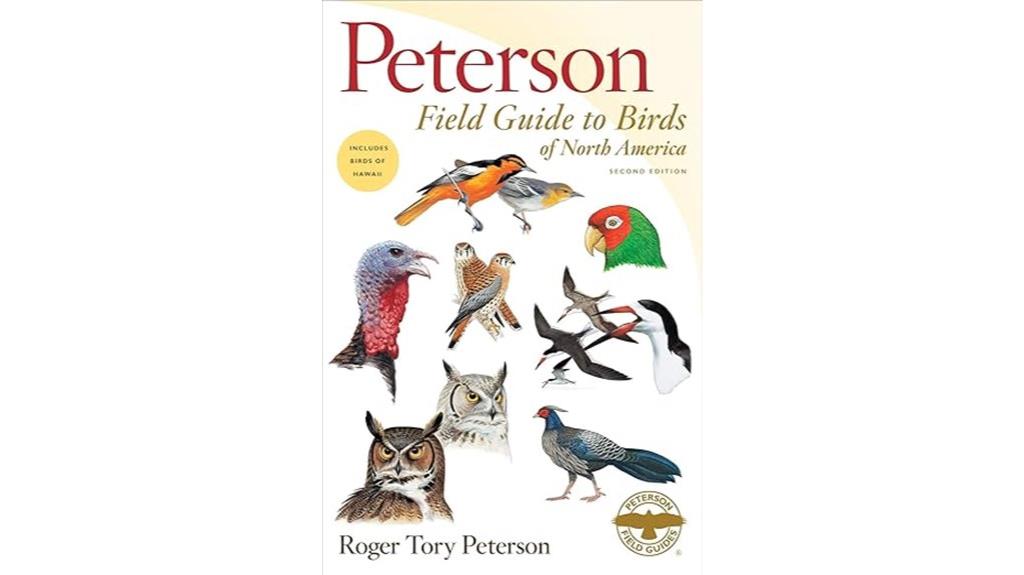
For birders who value detailed, accurate illustrations and exhaustive information, the Peterson Field Guide to Birds of North America, 2nd Edition, stands out as an excellent choice. Its larger format improves readability and field use, with clear drawings, silhouettes, and arrows highlighting key features. The guide covers North American birds comprehensively, including Hawaiian species, with detailed maps—though some are small or occasionally inaccurate. Its structure follows traditional taxonomy, making navigation quick. The guide offers in-depth details on identification, behavior, and habitat, making it useful for both beginners and experienced birders. Despite some weight and minor map issues, it remains a highly regarded, versatile resource.
Best For: birders who seek a comprehensive, detailed guide with accurate illustrations and in-depth information on North American and Hawaiian bird species.
Pros:
- High-quality construction with beautiful, detailed illustrations and silhouettes for quick identification
- Comprehensive coverage of North American birds, including Hawaiian species, with insightful notes on behavior and habitat
- Organized in traditional taxonomic order with helpful maps, index, and features like a life list section for notes
Cons:
- Larger format and weight may be cumbersome for field portability
- Some range maps are small or occasionally inaccurate, such as the Broad-tailed Hummingbird map
- Occasional errors in classification and packaging quality issues during shipping
The Field Guide to Dumb Birds of North America
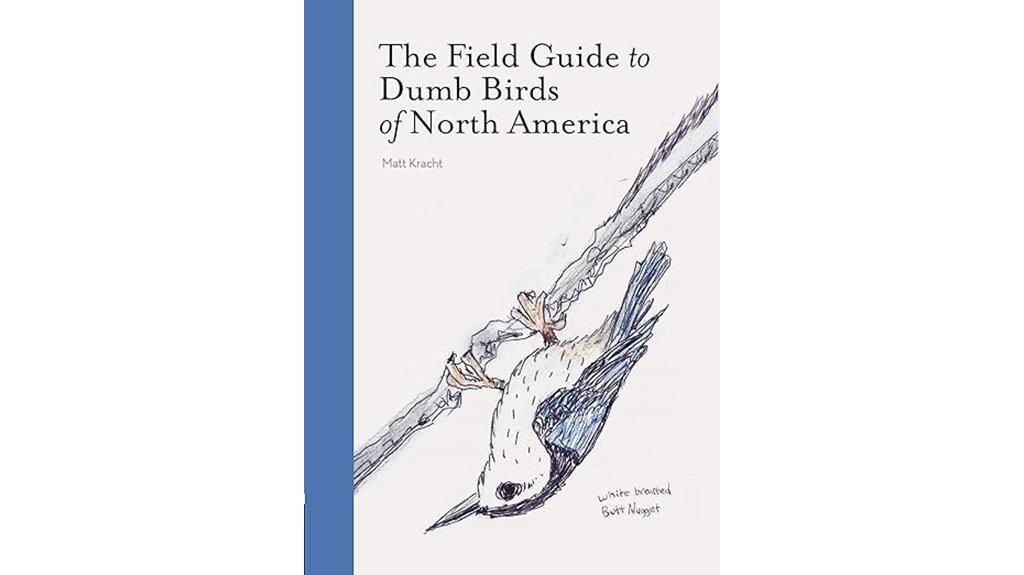
Looking for a bird book that combines humor with honest insights? “The Field Guide to Dumb Birds of North America” is perfect if you enjoy witty, candid takes on bird behavior alongside charming illustrations. This lighthearted guide blends funny blurbs with actual facts, celebrating the quirks and jerky moments of our feathered friends. It’s ideal for adult bird enthusiasts who appreciate humor and aren’t looking for a strict reference. The book’s snarky tone and personal stories make it a fun read, perfect for sharing laughs with fellow birders. Just be prepared for some colorful language and tiny print, but the humor makes it worth it.
Best For: adult bird enthusiasts and humor-loving nature lovers who enjoy witty, candid insights into bird behavior without needing a strict reference guide.
Pros:
- Humorous and entertaining, perfect for casual reading and sharing laughs
- Charming illustrations and honest, relatable anecdotes from the author
- Great gift idea for birders and nature fans who appreciate wit and personality in a field guide
Cons:
- Tiny, light font can be difficult for older readers to see comfortably
- Some language and humor may offend sensitive readers or be considered inappropriate
- Not a traditional or comprehensive bird identification guide, more of a fun, lighthearted read
North American Bird Watching for Beginners: Field Notes on 150 Species
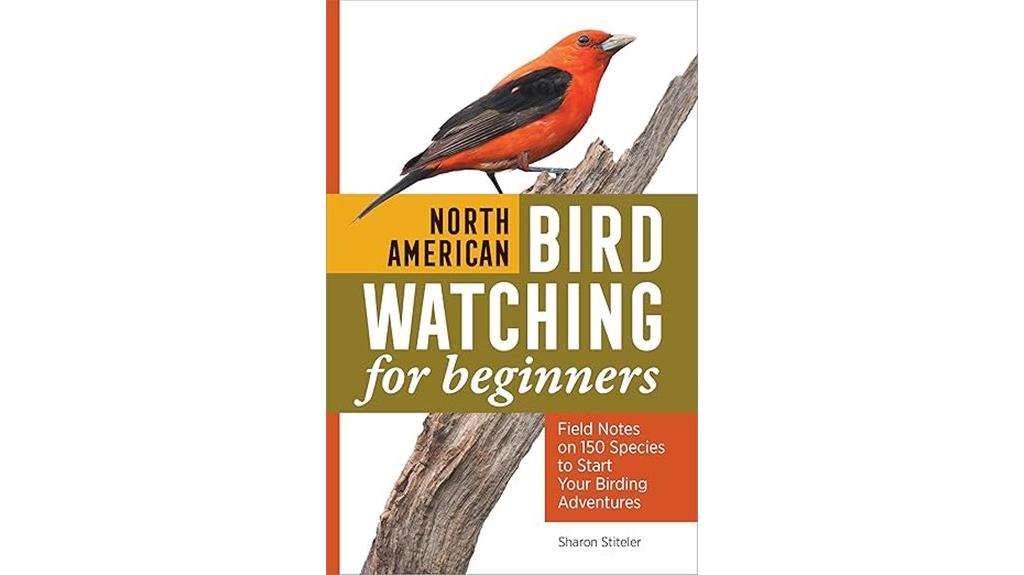
North American Bird Watching for Beginners: Field Notes on 150 Species stands out as an ideal guide for newcomers enthusiastic to start identifying birds with confidence. This book offers straightforward descriptions, stunning photos, and fun facts that make learning enjoyable. It covers common backyard visitors like finches and woodpeckers, with details on their behaviors, locations, and distinguishing features. The inclusion of pronunciation guides helps guarantee you say bird names correctly. Perfect for backyard birding, nature walks, or as a gift, it’s a practical and engaging resource that builds your identification skills while inspiring outdoor adventures.
Best For: beginner bird watchers and outdoor enthusiasts eager to learn about North American bird species with confidence and enjoyment.
Pros:
- Clear and concise descriptions suitable for beginners and experienced birders alike
- Beautiful photographs and fun facts that make learning engaging
- Useful pronunciation guides to correctly say bird names
Cons:
- Not designed for tracking individual bird sightings or detailed monitoring
- Some users may find the price on Amazon slightly high
- Primarily a species identification guide without in-depth behavioral or ecological data
National Wildlife Federation Field Guide to Birds of North America
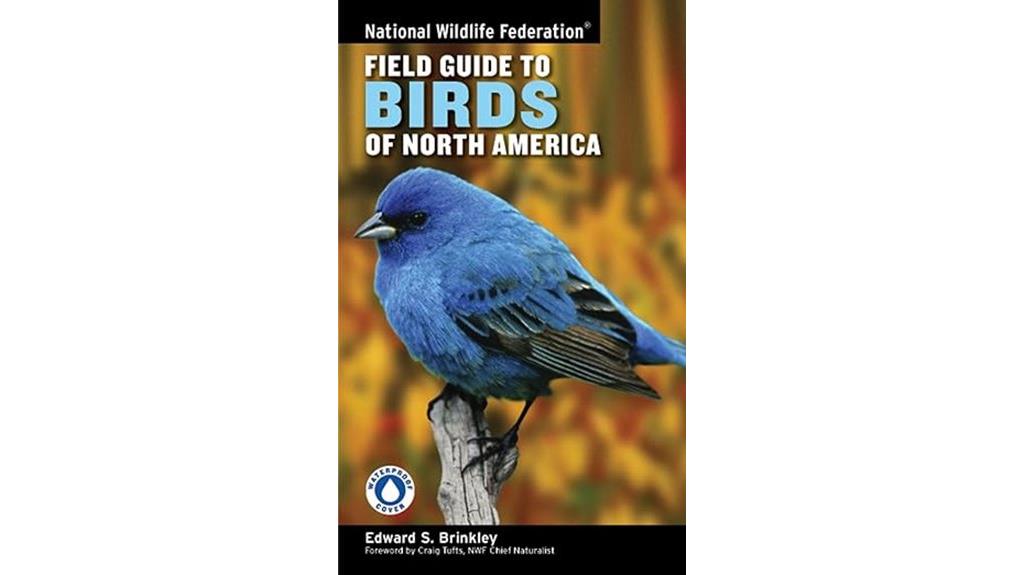
If you’re serious about bird identification and want detailed, in-depth information, the National Wildlife Federation Field Guide to Birds of North America is an excellent choice. It offers extensive details on bird species, including physical traits, behaviors, habitats, migration, and vocalizations. The guide features high-quality photos, range maps, and supplementary resources like checklists and glossaries. Organized by bird groups such as water birds, raptors, and songbirds, it helps users understand similarities and differences among species. While it’s thick and better suited for back-home reference, its exhaustive content makes it invaluable for dedicated birders seeking an authoritative, visually rich resource.
Best For: serious bird enthusiasts and experienced birders seeking an in-depth, comprehensive reference with detailed species information and high-quality visuals.
Pros:
- Extensive, detailed species descriptions including behavior, habitats, and vocalizations
- High-quality photographs and clear range maps facilitate accurate identification
- Includes supplementary resources like checklists, glossaries, and habitat information
Cons:
- Thick and bulky, making it less portable for field use
- Can be overwhelming for beginners due to its depth of information
- The non-linear organization and color-coded sections may be confusing for new users
National Audubon Society Birds of North America
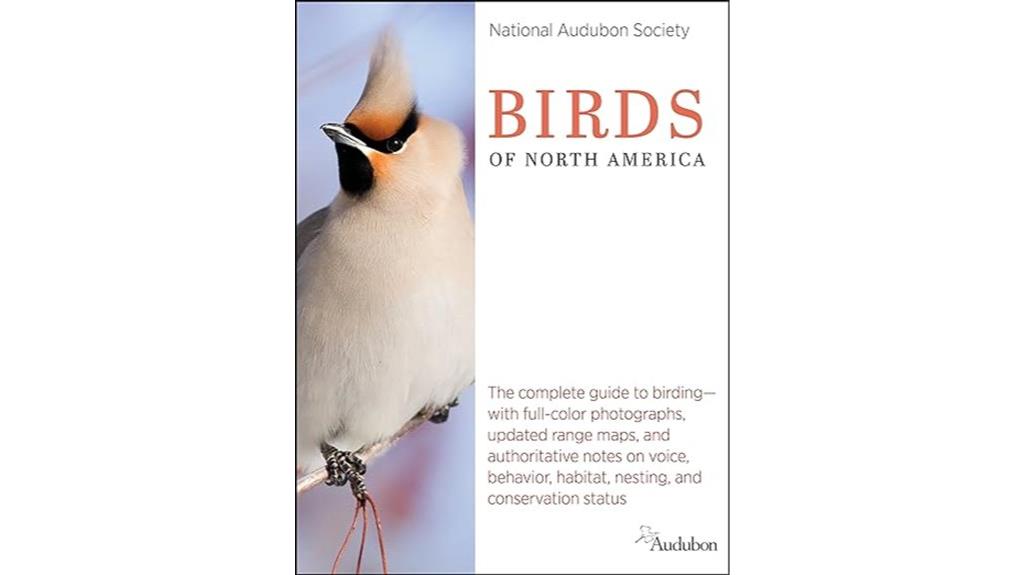
The National Audubon Society Birds of North America stands out as the best choice for bird enthusiasts seeking a highly detailed and reliable reference guide. This extensive book covers North American bird species with updated information, clear photographs, and detailed range maps. It offers in-depth descriptions of each bird, including conservation issues, making it ideal for both casual birders and serious enthusiasts. While most data is current, some maps may be slightly outdated. Overall, it’s a highly valuable resource that helps with identification, understanding habitats, and learning about conservation efforts. I highly recommend it as a must-have for any bird lover’s collection.
Best For: bird enthusiasts of all levels seeking a comprehensive, detailed, and reliable guide to North American bird species.
Pros:
- Highly detailed descriptions and extensive information on each bird species
- Clear photographs and detailed range maps aid in identification and learning
- Up-to-date content reflecting recent changes in bird populations and distributions
Cons:
- Some maps may be slightly outdated or contain minor inaccuracies
- The book’s comprehensive nature may be overwhelming for casual readers or beginners
- Its large size and weight can make it less portable for field use
National Audubon Society Field Guide to North American Birds
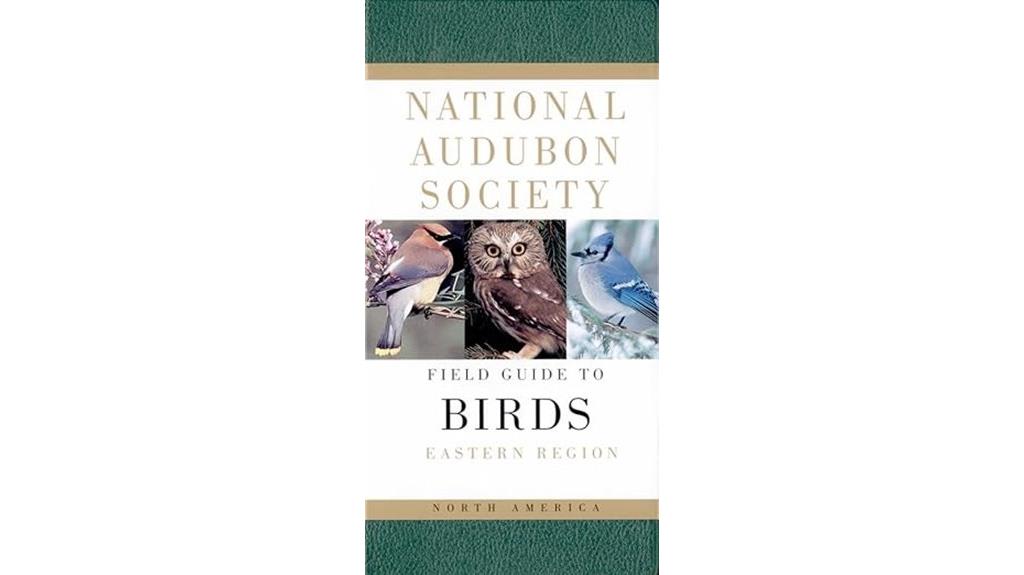
The *National Audubon Society Field Guide to North American Birds* is ideal for birdwatchers who appreciate an exhaustive, straightforward reference, especially those who enjoy exploring eastern bird species in natural settings. I’ve relied on it for years, valuing its detailed descriptions, sharp photographs, and quick identification key. While its glossy pages are durable, they can be tricky in wet conditions, and the photos often show birds from only one angle. Still, it’s a beloved classic that offers all-encompassing coverage, making it perfect for field use. Paired with the Audubon app, it’s a dependable tool for both novice and experienced birders alike.
Best For: birdwatchers who enjoy exploring eastern North American bird species with a comprehensive, easy-to-use reference in natural settings.
Pros:
- Extensive coverage of eastern North American birds with detailed descriptions and sharp photographs
- User-friendly organization with quick identification keys, ideal for field use
- Affordability and nostalgic appeal, making it a beloved classic among birders
Cons:
- Photographs show birds from only one angle, limiting identification from different perspectives
- Glossy pages, while durable, are less water-resistant and can be problematic in wet conditions
- Less durable and less field-friendly compared to guides with thicker, moisture-resistant paper like Nat Geo or Sibley
The Sibley Field Guide to Birds of Eastern North America (Second Edition)

Looking for a bird guide that balances detailed information with portability? The Sibley Field Guide to Birds of Eastern North America (Second Edition) fits the bill perfectly. It offers exhaustive species descriptions, habitat info, and migration maps, all with stunning artwork and accurate photos. Its compact size makes it easy to carry on field trips, and the sturdy binding ensures durability outdoors. While some find the artwork small, most appreciate its organization and helpful tips for distinguishing similar species. It’s ideal for beginners and experienced birders alike, making it a must-have for anyone serious about bird identification in eastern North America.
Best For: bird enthusiasts of all levels seeking a portable, comprehensive guide to identify and learn about eastern North American birds.
Pros:
- Detailed species descriptions, habitat info, and migration maps included
- Compact size and sturdy binding for easy use in the field
- High-quality artwork and accurate photographs enhance identification
Cons:
- Some users find the artwork and text small and hard to see
- Lacks digital features like bird songs or videos, which could enhance field identification
- The smaller format may require some acclimation for new users unfamiliar with its layout
Kaufman Field Guide to Birds of North America Hardcover Kenn Kaufman

If you’re a beginner or casual birder seeking a durable and easy-to-use field guide, Kaufman’s Field Guide to Birds of North America is an excellent choice. It’s small, lightweight, and sturdy, fitting easily into large coat pockets or backpacks. With about 390 pages, it’s designed for field use, featuring a durable cover that withstands outdoor conditions. The well-organized sections and pictorial table of contents help you navigate quickly. While some find it slightly heavy for pocket carry, it’s perfect for backpack or car use. The concise descriptions, helpful photos, and quick-reference features make it ideal for learning and confirming bird identifications in the field.
Best For: beginner and casual birders seeking a durable, easy-to-use, and portable field guide for quick bird identification in North America.
Pros:
- Compact, lightweight, and sturdy design ideal for field use and outdoor conditions
- Well-organized sections and pictorial table of contents facilitate quick navigation
- Concise descriptions with helpful photos and identification features suitable for learners
Cons:
- Slightly heavy for pocket carry, making it less portable in small pockets
- Photos are decent but could be clearer or more numerous for easier identification
- Layout may sometimes be confusing regarding which images correspond to specific birds
National Geographic Backyard Guide to Birds of North America, 2nd Edition
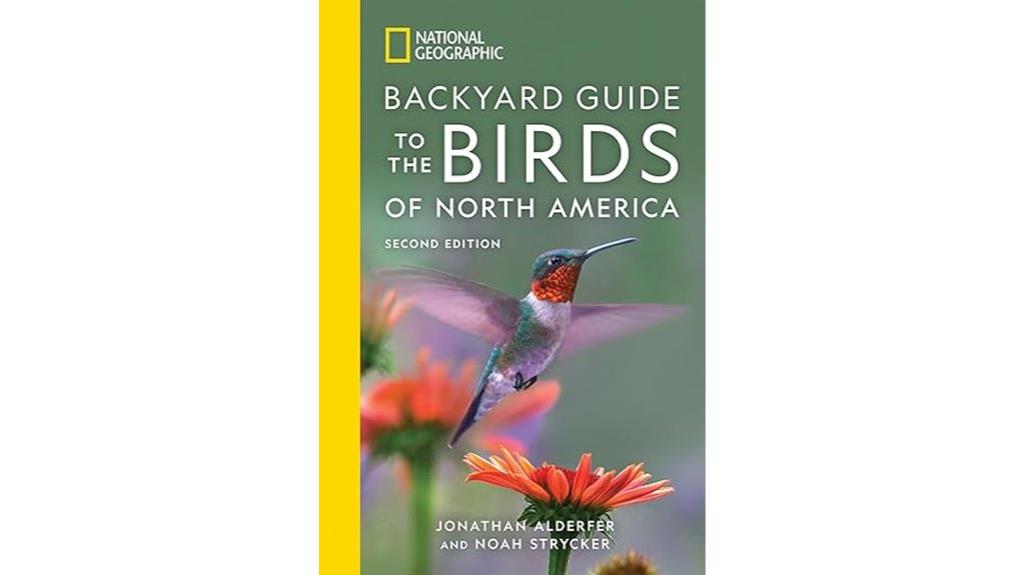
Bird watchers of all experience levels will find the National Geographic Backyard Guide to Birds of North America, 2nd Edition, especially useful because it combines stunning photos with detailed species descriptions. I appreciate how the book includes clear maps of habitats, along with information on food, nesting, plumage, and vocalizations. It’s well-organized with easy-to-use indices that make quick identification simple, whether I’m spotting a chickadee or a finch. The high-quality visuals and practical layout make it a go-to resource for backyard birding. I’ve recommended it to friends and family, and it’s become a trusted tool for both beginners and seasoned birders.
Best For: bird enthusiasts of all experience levels seeking a visually appealing, easy-to-use guide for identifying North American backyard birds.
Pros:
- Combines stunning photos with detailed species descriptions for accurate identification
- Includes clear habitat maps and comprehensive information on food, nesting, plumage, and vocalizations
- Well-organized with user-friendly indices, making quick look-ups and in-depth research simple
Cons:
- As a physical book, it may be less convenient for field use compared to digital apps
- Might be too detailed for casual bird watchers who prefer quick references
- Limited coverage outside of North American bird species, not suitable for international birding
Birds of North America: A Guide to Field Identification
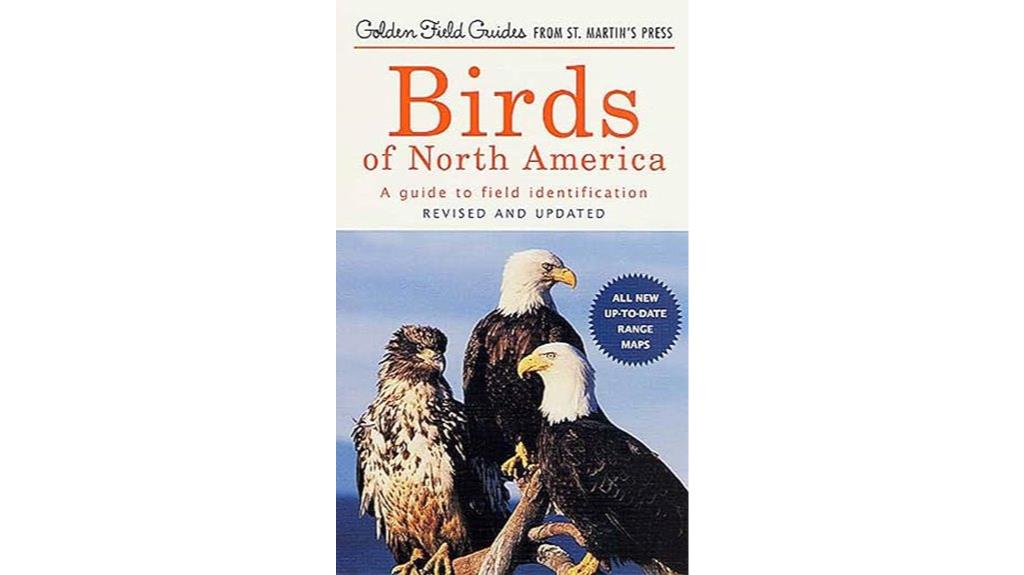
This field guide excels for beginner and casual birders who need a portable, easy-to-use resource in the field. Its compact, durable design makes it perfect for outdoor adventures, fitting easily into small packs. The detailed illustrations emphasize key field marks better than photos, aiding quick identification. Range maps, often updated for changing bird distributions, include migration lines for better context. Each species is on a single page with concise descriptions, comparison charts, and sometimes song sonograms. Although some editions lack check-off boxes, the guide remains highly user-friendly, fostering confidence in identifying North American birds. It’s an ideal starter tool before moving on to more advanced guides.
Best For: beginner and casual birders seeking a portable, user-friendly guide to North American birds in the field.
Pros:
- Compact, durable design ideal for outdoor use and easy to carry in small packs.
- Detailed illustrations that highlight key field marks better than photographs for quick identification.
- Concise, single-page species entries with comparison charts and updated range maps, including migration lines.
Cons:
- Many editions are reprints with minimal updates, leading to outdated taxonomy and limited recent range information.
- Small range maps can be difficult to interpret without overprinted borders or detailed context.
- Lacks advanced features like extensive taxonomic data or check-off boxes found in more comprehensive guides.
The Stokes Field Guide to the Birds of North America (Stokes Field Guides)
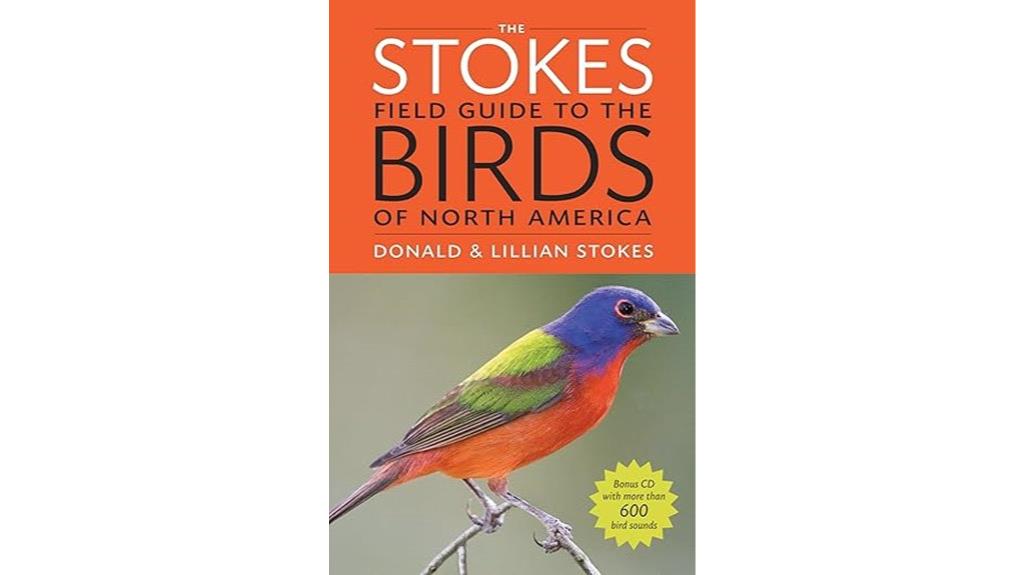
The Stokes Field Guide to the Birds of North America stands out as an excellent choice for serious birders who prioritize detailed visuals and all-encompassing coverage. As a long-time bird book collector, I appreciate its high-quality photographs—multiple shots per bird, including perching and flying, with detailed notes on gender and maturity. The range maps are conveniently on the same page, making quick identification easier. Although heavy at around 3 pounds, it’s perfect for home or vehicle use. The included CD with over 600 bird calls adds valuable context. Overall, it’s a exhaustive, reliable resource—ideal for dedicated birders seeking depth and clarity.
Best For: serious birders and bird book collectors seeking a comprehensive, high-quality reference guide with detailed images and range information.
Pros:
- Exceptional, high-resolution photographs with multiple shots per bird, including various postures and plumages
- Convenient range maps on the same page as the bird, facilitating quick identification
- Includes a CD with over 600 bird calls, enhancing understanding of bird sounds and behavior
Cons:
- Heavy weight (around 3 pounds), making it less practical for extensive field use or carrying during birding trips
- Slight regional bias towards Eastern North American birds, with some Western species less represented or under-detailed
- Large size limits portability, making it more suitable for home or vehicle reference rather than portable field guiding
Peterson Field Guide to Birds of Western North America, 5th Edition

If you’re a serious bird watcher looking for an all-encompassing and user-friendly guide, the Peterson Field Guide to Birds of Western North America, 5th Edition, stands out as an excellent choice. It offers detailed illustrations, range maps, and specialized sections for Hawaii and hawk views, making identification easier. The guide’s organization, with related species on adjacent pages, enhances usability. Updated in 2020, it integrates range maps with descriptions, using color coding for quick reference. Printed on durable paper with a weather-proof cover, it’s perfect for field use. Whether you’re a beginner or an advanced birder, this guide provides exhaustive, reliable information for identifying birds across Western North America.
Best For: Serious bird watchers and enthusiasts seeking a comprehensive, easy-to-use field guide with detailed illustrations and integrated range maps for Western North America.
Pros:
- Highly detailed illustrations with multiple views and key identification features
- Updated 2020 edition with integrated, color-coded range maps for quick reference
- Durable, weather-proof cover and quality paper suitable for field use
Cons:
- Slightly larger size may require bigger pockets or carrying cases
- Some users might find the extensive content overwhelming for casual birders
- Price point may be higher compared to simpler or less comprehensive guides
Factors to Consider When Choosing Field Guides for North American Birds

When choosing a field guide, I consider how clear the identification features are and whether the geographic range information is accurate. I also weigh the quality of illustrations versus photos, along with how portable and durable the guide is for field use. These factors help guarantee I find a guide that’s practical and reliable for my birding adventures.
Identification Features Clarity
How can you quickly and accurately identify North American birds? Clear, detailed illustrations and photographs are essential. They highlight key field marks and diagnostic features, making it easier to distinguish similar species and seasonal plumages. Well-labeled images that focus on specific traits like bill shape or wing pattern help reduce confusion. Descriptive text that emphasizes these distinctive traits further enhances clarity, guiding you to accurate identification. Range maps with seasonal and geographic info narrow down options based on your location, increasing confidence. Additionally, guides that showcase multiple plumages, sexes, and age groups ensure you see the full range of variation. Together, these features create a thorough, user-friendly resource that sharpens your bird ID skills.
Geographic Range Accuracy
Accurate geographic range maps are essential for confirming a bird’s presence in your area, especially since many species have overlapping habitats or migratory paths. Reliable range maps help you determine if a species is likely to be present during a specific season, reducing misidentification. It’s vital to choose guides with regularly updated range data, reflecting climate change, habitat shifts, and new migration information. Outdated or broad range boundaries can lead to confusion, especially with similar species sharing overlapping zones. Detailed range details, including seasonal distribution and migration corridors, improve identification accuracy. Digital guides or recent print editions typically offer more precise, current range information compared to older, less frequently revised resources. This focus ensures you’re working with the most reliable data during your birdwatching adventures.
Illustrations vs. Photos
Choosing between illustrations and photographs in a field guide depends on your learning style and what you find most helpful for identification. Illustrations often highlight key features, emphasizing markings and plumage variations, making them ideal for studying distinguishing traits. They can show multiple views—side, top, wings—and illustrate different plumages, which photos typically don’t. Photographs, however, depict birds in natural settings and postures, giving context that helps recognize species in the wild. While photos provide realism, they can sometimes obscure subtle details due to lighting or angle. Illustrations are tailored to emphasize specific features, making identification easier for visual learners. Ultimately, your choice hinges on whether you prefer detailed, stylized visuals for feature comparison or real-world images for situational recognition.
Portability and Size
Selecting the right field guide for North American birds involves considering its size and portability, especially if you plan to carry it into the field. Smaller, lightweight guides are ideal for quick reference and easy to carry, fitting comfortably in pockets or small bags. They’re perfect for active birders who need quick access without bulk. Larger guides offer more detailed illustrations and extensive information but can be bulky and harder to manage on the move. Durable binding and moisture-resistant pages are important to withstand outdoor conditions. Some guides are designed to be pocket-sized or compact, balancing readability with convenience. Heavier or larger guides often require backpacks or car storage, while smaller options keep your hands free and make field identification more effortless.
Durability and Field Use
When you’re out in the field, the durability of your bird guide can make all the difference between a helpful tool and a frustrating distraction. A guide with a laminated or vinyl cover can withstand rough handling and exposure to the elements, preventing tears and damage. Pages should be resistant to moisture, dirt, and wear, with glossy or laminated finishes to keep them intact during active birding. The guide’s size and weight also matter—lighter, compact options are easier to carry on long outings. Additionally, a well-constructed binding, such as sewn or reinforced, guarantees pages stay secure after frequent use. Waterproof or weather-resistant materials further boost longevity, allowing your guide to perform reliably in various outdoor conditions.
Content Depth and Detail
Have you ever struggled to identify a bird because your guide lacked enough detail? If so, you know how frustrating it can be. Field guides differ greatly in their depth of information—some offer brief descriptions, while others provide extensive accounts of physical traits, behaviors, and vocalizations. The amount of visual content, like illustrations, photos, and range maps, also impacts how well you can identify birds. Guides with detailed descriptions of plumages, molts, and seasonal changes help distinguish individual birds across different stages of life. Coverage scope matters too—subspecies, hybrids, and regional variations can make or break your identification accuracy. Ultimately, the right balance of concise summaries and in-depth data should match your experience level and specific interests in birding.
User Experience Ease
Choosing a user-friendly field guide can make all the difference in enjoying and succeeding at birding. A good guide features clear, concise text and well-organized sections that let you find information quickly. Easy-to-read illustrations, maps, and labels help you identify key features without confusion or needing extensive prior knowledge. When visual content and descriptions are integrated on the same or facing pages, flipping back and forth becomes unnecessary, saving time and effort. Simple indexing methods, like quick find tabs or color-coded sections, allow you to locate species or groups rapidly in the field. Additionally, multimedia support—such as range maps, calls, and helpful tips—enhances usability and reduces frustration, making your birding experience more enjoyable and efficient.
Price and Value
Ever wondered how to find a field guide that offers the best value for your money? The price of North American bird guides varies widely—from affordable pocket-sized editions to expensive exhaustive volumes. Consider your budget and how much detail you need. Higher-priced guides often feature detailed illustrations, extensive range maps, and extra content, making them worthwhile for serious birders. Budget-friendly options may lack some features but still serve beginners or casual observers well for basic identification. Comparing the cost to coverage, durability, and usability helps determine if you’re getting good value. Investing in a well-reviewed, durable guide can save money over time by reducing the need for multiple resources and ensuring it remains useful during many birding seasons.
Frequently Asked Questions
How Do I Choose a Field Guide for My Specific Region?
When choosing a field guide for your region, I recommend considering your location first. Look for guides specific to your area, as they’ll have the most relevant species and details. Check the size and format—smaller guides are portable, while larger ones offer more info. Also, consider if you prefer illustrations or photos, and guarantee the guide is easy to carry and navigate during your birdwatching adventures.
What Features Differentiate Beginner Guides From Advanced Ones?
Think of beginner guides as training wheels—they’re straightforward, with simple language and larger photos to get you started. Advanced guides, on the other hand, dive deeper, offering detailed descriptions, range maps, and subtle distinguishing features for seasoned birders. They’re not afraid to challenge you, helping you sharpen your skills. Whether you’re just starting out or an expert, choosing a guide that matches your experience level makes all the difference.
Are Digital or App-Based Guides Better Than Print Guides?
When choosing between digital or app-based guides and print guides, I find that digital options are incredibly convenient. They offer quick searches, updates, and interactive features, which make bird identification easier in the field. However, I still appreciate print guides for their reliability and ease of use without battery worries. Ultimately, I recommend having both, depending on your situation and preference, to enhance your birdwatching experience.
How Often Should I Update or Replace My Field Guide?
Think of your field guide as a trusted map on a journey. I believe you should update or replace it when it starts showing outdated landmarks or new routes. Usually, every 3-5 years, I check for new editions, especially after major bird classification updates. If the pages are worn or information is obsolete, it’s time for a fresh guide. Staying current helps me navigate birdwatching adventures confidently.
Can I Use a Single Guide for Multiple Bird Habitats or Regions?
Using a single guide for multiple habitats or regions can work if it’s thorough and well-illustrated, but I recommend having at least one regional guide. Different areas often have unique species, and regional guides provide more detailed descriptions and photos. This way, you’ll improve your identification skills and enjoy birdwatching more, especially when exploring diverse habitats. Balancing a general guide with regional ones is the best approach.
Conclusion
So, whether you’re just starting out or looking to deepen your birding adventures, choosing the right guide can open doors to a whole new world. Think of it as your trusted companion—there to gently steer you through the whispers of feathers and melodies in the trees. With a bit of patience and the perfect guide in hand, you’ll find yourself more enchanted with every sighting. Happy birding—your next great discovery is just a page away.
